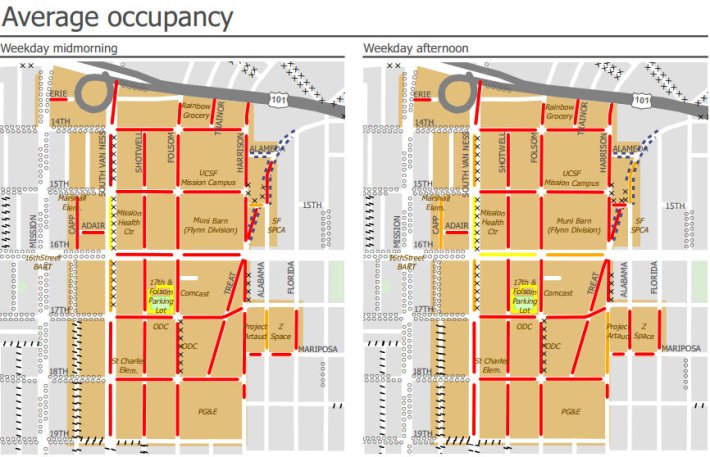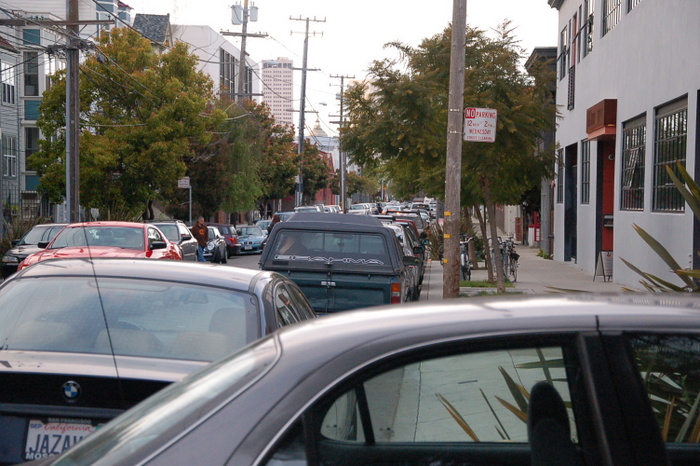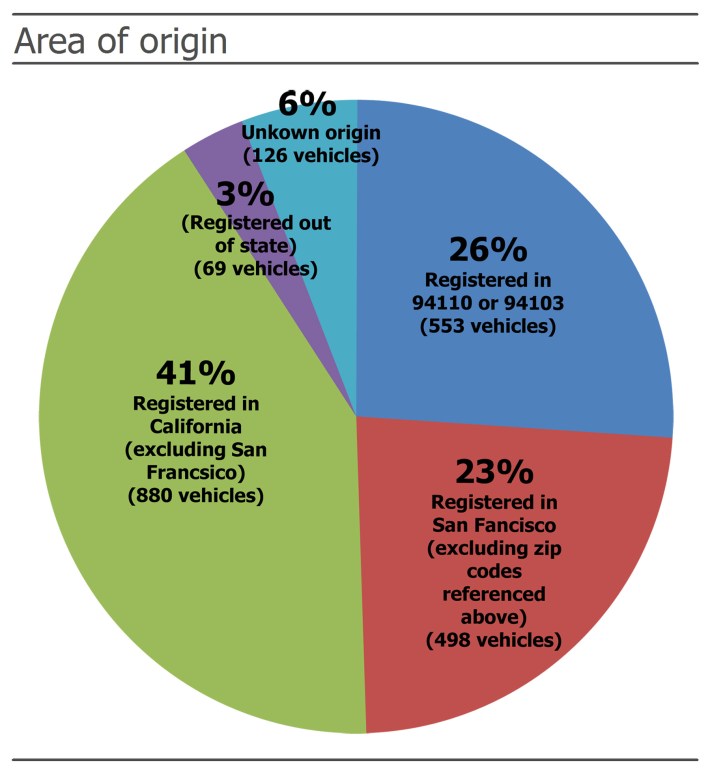Following fierce opposition that led the SF Municipal Transportation Agency to roll back its first attempt to expand car parking meters in the northeast Mission, the agency re-started a community process last night to develop a plan for managing parking demand in the area. The meeting was seen as a litmus test for the public's openness -- and the agency's tact -- which will be key to implementing parking meters and permit restrictions to reduce cruising for parking in a dense, complex neighborhood where parking problems are only expected to get worse.
The area is centered around a 220-space parking lot at 17th and Folsom Streets that's set to be closed within months and converted into a new park and affordable housing development. As it is, the SFMTA said the area is basically a vacuum of free, unregulated parking surrounded by streets with meters and permit restrictions, making it a magnet for car commuters and long-term car storage that fills parking spots to the brim during the day. A presentation explaining the data and the rationale for using parking pricing to manage demand was made by Jeffrey Tumlin, a principal at Nelson/Nygaard, a consultant firm working on the project with the SFMTA.
"Everyone knows that you can park free all day, all week -- you can leave your car here and go to the airport," Tumlin told the audience, noting that drivers in the area reportedly circle for parking for a half hour, on average. "People are coming from all over to park in your neighborhood."
Unlike the original planning process, SFMTA officials didn't present any proposed parking plan at the first meeting -- its stated goal was simply to present the block-by-block parking data collected in recent months and field input from residents to help inform a future proposal.
Tumlin explained that planners aim to account for the mix of land uses in the neighborhood, including residences, retail shops, and "production, distribution, and repair" businesses -- many of which, unlike retail merchants, prefer free vehicle storage over the elevated parking turnover that meters bring. "It is the most complicated mosaic of land uses that I've seen, really, in any place I've worked anywhere in the world," he said.
That the SFMTA didn't adequately account for that complexity was one of the major sources of complaints against the original parking meter plan, which had been presented to residents as part of a larger plan to expand the SFPark smart meter program to manage parking in and around Mission Bay, where major developments are expected to bring an influx of car commuters into the area. The SFMTA took SFPark meters out of the equation, opting for conventional meters instead, to address skepticism voiced by opponents about the efficacy of SFPark. The agency also plans to eventually re-start the planning process in the Dogpatch and Potrero Hill neighborhoods, which were also included in the original plan, "one neighborhood at a time," said agency spokesperson Paul Rose.
Of the several hundred attendees at the meeting, it's unclear how many were willing to listen and how many were absolutely committed to the status quo of free parking, regardless of data. While the discussion following Tumlin's presentation was mostly cordial, he did field a few heated complaints about paying for parking meters (one merchant even stormed out after ranting), and there were a few outbursts from some sections of the audience, though others asked them to take turns to facilitate the discussion.

Opposition in the neighborhood has been led by the Eastern Neighborhoods United Front (ENUF). Mari Eliza, a spokesperson, passed out a flyer reading, "The SFMTA is Creating New Parking Restrictions in the Mission!! Businesses need and support parking in our neighborhoods and the SFMTA is changing the rules." The flyer also depicted a family riding in a car, saying, "We want to shop and eat in the Mission!"
When Streetsblog asked Eliza about the merchants and customers who prefer having paid meters to create predictably available parking in front of shops and restaurants, she responded, "I don't get that."
"What I'm getting from the people who live in the neighborhood, the people who talk to the shopkeepers and the restaurants, their customers are complaining to them because they can't park," she said. When asked, "What do you mean they 'can't park?,'" she responded, "The customers can't park. Whatever it means."
When asked for ENUF's proposed solution to the parking crunch (though many opponents denied there is a parking problem), Eliza said the SFMTA should find a way to create new parking spaces to accommodate the out-of-town drivers who park to take BART downtown at 16th Street for free. However, she couldn't say which real estate in the dense neighborhood could be given over to parking: "It's not my job to figure that out."
In response to an ENUF petition that asked the SFMTA to completely stop installing new parking meters, sustainable transportation advocate Mario Tanev recently formed a group supporting the SFMTA's efforts to manage parking demand called sfMORE. While Tanev's counter-petition has collected 280 signatures to ENUF's 721 (unsurprisingly, it's easier to rally people defending their access to free parking than those who support parking reform), a noticeable contingent of advocates backing parking reform attended the meeting.
In a letter addressed to sfMORE members, Tanev said attendees voiced some legitimate concerns, but "unfortunately, many in the audience just tried to shut it down. The data didn’t matter to them, and the public process that has set the current policy didn’t matter to them. They wanted it to be their way or the highway."
"The policies are set via a well-deliberated public process, then fine-tuned using a public process, and the data is gathered in high detail and then fine-tuned using feedback from the neighborhood," he added. "Isn’t this what we all want?"
Livable City Executive Director Tom Radulovich praised the SFMTA's neighborhood-scale approach as an improvement on the block-by-block approach taken with parking meter expansions in the past. "I think they're basically on the right track here," he said. "They may or may not convince the people in this room of that, but I think they're basically on the right track."
The SFMTA's original timetable included appointment-based meetings with neighborhood groups, and even specific individuals, preceding another community meeting in January, where agency staff would present a proposal for feedback, with meter implementation set for next summer. But some vocal attendees complained that more time for individual meetings and an additional feedback meeting was needed, and SFMTA Director of Transportation Ed Reiskin agreed to revise the schedule to make both of those changes.
Some parking reform advocates were skeptical as to whether the most ardent opponents could be won over with more meetings, or if requesting them is just a gambit to delay the process.
"It is an emotional issue," said Radulovich. "There's the science of parking, and the religion of parking. The two don't mix well."










